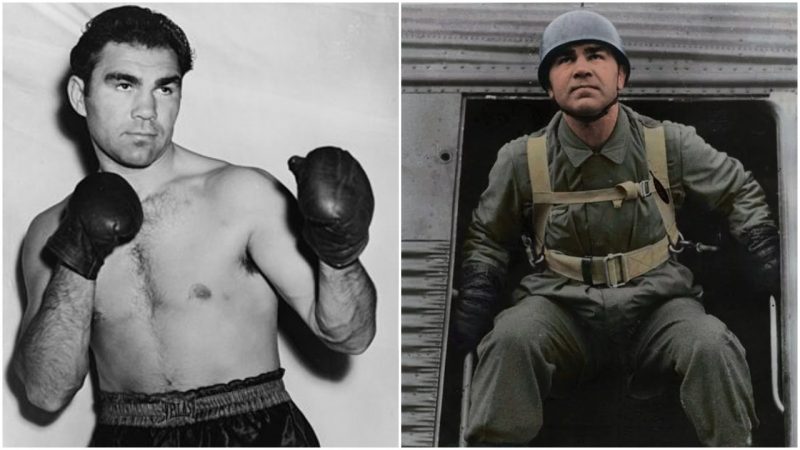Max was ordered to the Fallschirmjäger. That was no accident. Goebbels and Hitler both wanted Schmeling to “die a hero’s death”
Max Schmeling. Boxer. Nazi poster boy. Joe Louis’ punching bag. That’s all most people know about the man who held the world heavyweight boxing title from 1930-32. And you know, much of that is correct – but there is another side to Max Schmeling, the boxer and the man, that many people don’t know about.
Sure, Joe Louis beat him badly in 1938.
People who lived during the time (my New York City-born and bred mother being one of them) will tell you that on the night of the Louis-Schmeling fight in 1938, not only NYC, but most of the United States came to a standstill – city blocks went quiet except for the sounds of radios blasting the voice of the fight announcer from every window, and for the cheers when Louis was doing well.
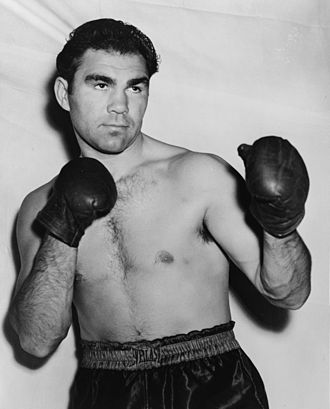
In that fight, Louis, a black American who couldn’t travel safely in many parts of his own country, was fighting a supposed Nazi, and both people and governments imbued the fight with a symbolism far beyond a contest between two athletes.
The fight had become a proxy battle between Nazism and Democracy. When Louis won the fight, most of America went crazy. “Now Hitler really knows who the Superman is!” people seemed to say.
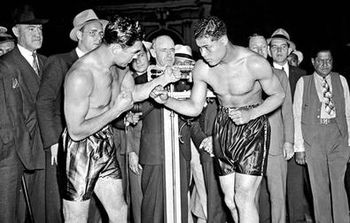
All Max Schmeling wanted to be was a fighter. As a teen, he had seen newsreels in Germany of the great American champion Jack Dempsey and decided then and there that he wanted to be a fighter. Truth be told, with a face like Max’s, he really was destined for it.
People who haven’t seen a picture of the man, but know of the Louis fight and the legend around it, sometimes picture a giant blond “Aryan Superman” in the ring – like the Ivan Drago of the Rocky and Creed movies. Honestly, Max looked like a pug – which was a slang term for boxers back then: short for “pugilist.”
He may have had a head that looked like it was made of granite, a caveman-like forehead and eyebrows, and kind of a dull look, but Max was actually quite smart, astute, and good-natured.
He began fighting in 1924 at the age of 19, and within four years had made a name for himself in Europe, winning the German light-heavyweight title in 1926. He even sparred with his hero Jack Dempsey in 1925. Dempsey, according to those there, had nothing but good words to say about the German fighter.
Like today, though, if a fighter is going to “make it” he has to go to the USA, which is what Schmeling did in 1928 after winning both the German and European Heavyweight titles.
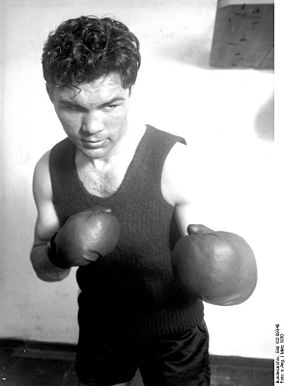
When Schmeling came to America, a lot of managers, promoters, and sports-writers thought he was an over-rated European “stiff” with little style. During his first year in the USA, he garnered little attention, but kept working and fighting, finally destroying a former heavyweight contender in 1929’s “Fight of the Year.”
After winning a few more fights, Max was given a title shot against champion Lithuanian Jack Sharkey (real name Juozas Zukauskas). In a controversial match that Schmeling won because Sharkey was disqualified for a low-blow, Max became the first European heavyweight champion and the first German to hold that title.
All criticism about Max’s fight with Sharkey faded when he won his next fight against future boxing hall-of-famer Young Stribling, but Max lost the title when he lost his rematch against Sharkey in a match that many believed was crooked.
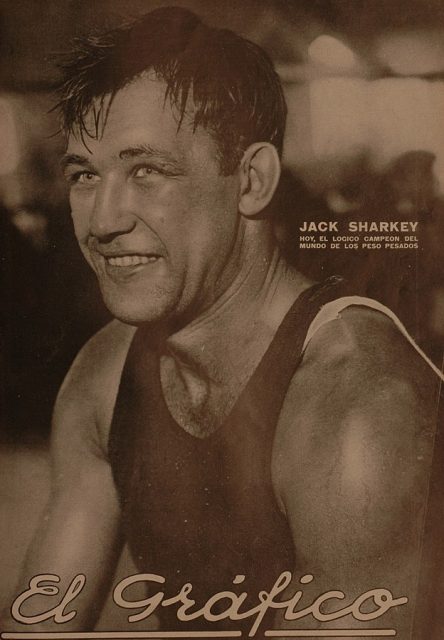
Schmeling went on to fight whenever he could, and one fight, against new sensation Max Baer, cemented Max’s unfair label as a Nazi puppet. The fight took place in June 1933, just months after Hitler came to power. Bad press had already started to pour out of Germany, and fight fans in America (mostly people in America’s multi-ethnic cities) had begun to associate anything German with Hitler.
Ironically, the promoter for the fight was former champ Jack Dempsey. Dempsey teamed with Baer to play up an angle that was certain to give the fight more publicity: Baer’s father was Jewish. It didn’t matter that Baer wasn’t a practicing Jew in the slightest – though he wore a Star of David on his trunks, often to rile up anti-Semites in the crowd – Baer fed off hostility.
So, for the Schmeling fight, the angle was “Nazi Bad Guy against Wholesome American Jewish Boy Baer.” The fight was anything but, but that didn’t matter. This was the beginning of Schmeling’s being labeled a Nazi. When Baer beat him, it wasn’t just the American fighter that beat him, but the country as well.
Schmeling got destroyed in the fight, unable to cope with Baer’s aggressive unorthodox style – and his dirty tactics, which included backhands, low-blows, elbows, and rabbit punches. After the fight, people began to wonder whether Schmeling still “had it.”
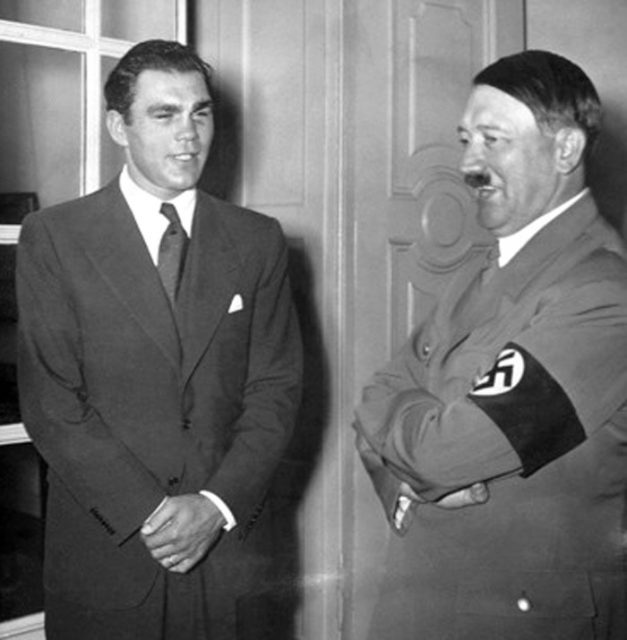
Max went back to Germany, trained hard, and won three of his next four fights over the next two years. By the time the first Louis fight was made in 1936, Schmeling had been away from America for a while, and people not only thought of him as washed up but also as a Nazi stooge. They also knew that Louis was supposed to be the “next great thing” and could hit like a jack-hammer.
On the cruise to America for the fight, Schmeling was interviewed by newsmen in front of newsreel cameras. Over and over during the trip, and when he arrived in New York, Max told anyone who wanted to listen that he “saw something” in the way Louis fought that made him believe he himself could win – but only Max and his team believed it.
When the fight took place on June 19, 1936, the first three rounds were close and competitive. In the 4th round, Louis, who had never been knocked down, was flattened by Schmeling, who had seen that every time Louis threw a left jab, he dropped that hand coming back. After one jab, Schmeling threw a hard right, flooring the American, though he got up to continue.
Schmeling then jabbed and jabbed throughout the fight, puffing Louis’ eyes and making it hard for him to see. In round 12, Schmeling hit Louis with a right to the body followed by another to the jaw…and Louis was counted out by the referee.
Max Schmeling was the only man to knock out Joe Louis, except when Rocky Marciano did it at the very end of Louis’ career.
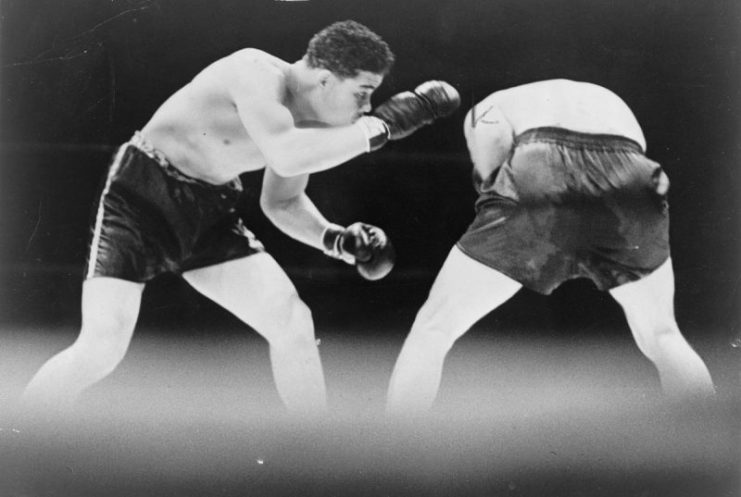
Date 20 June 1936
Schmeling was supposed to get a title shot against Cinderella Man James Braddock, but by 1936-37, no one wanted to give a “Nazi” a shot at the title. Truth be told, Schmeling did return home to Germany after the Louis fight a national hero and was feted by the Nazi Party and its bigwigs. He didn’t turn down their attention, but how could he have?
He did not adhere to their ideas of racial superiority – even going so far as to help two Jewish boys escape Nazi persecution during the Night of the Long Knives, and refusing to fire his Jewish-American manager, Joe Jacobs, when Josef Goebbels insisted on it.
Still, in America, Max was a Nazi. When Louis beat Braddock for the championship, things changed. Now, Joe could get revenge against “the Nazi” and people would pay to see it. As we know, Louis destroyed Max in the first round, knocking him down three times before the fight was stopped. Americans went wild. Hitler was “not pleased.”
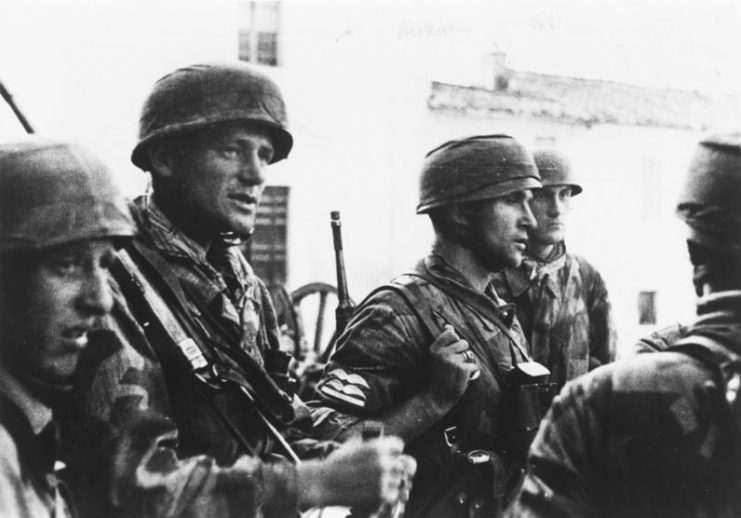
When the war broke out, Max was ordered to the Fallschirmjäger, the German paratroops – among the most dangerous jobs in the army. That was no accident. Goebbels and Hitler both wanted Schmeling to “die a hero’s death” so they could at least regain some face after his defeat by the African American fighter.
In the Battle of Crete, Schmeling was wounded almost immediately, mortar fire tearing into his knee. He was then removed from combat duty and made a training officer. At times during the war, he visited American POWs and, when he could, tried to improve living conditions for those he visited.
When the war ended, Schmeling had a hard time getting “de-Nazified,” the process the Allies used to vet people to make sure they hadn’t been involved in war crimes or were dedicated Nazi Party members.
Schmeling had never been a Party member, but his name did appear on a book about the superiority of German athletes. It had been ghost-written by the Ministry of Propaganda and was full of the usual Nazi nonsense. Schmeling was blamed for it until notable Americans spoke up for him.
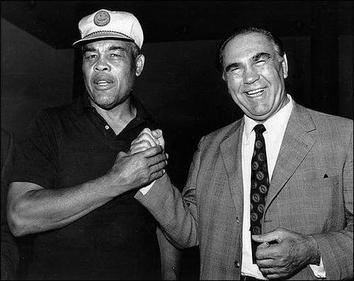
Joe Louis (left) poses with Max Schmeling in 1971
For the years immediately after the war, Max put on exhibitions for Allied troops for a little money and won three of five professional fights before retiring for good. Now the question was: what was he going to do for a living?
Fate stepped in and he was approached in Germany by an American acquaintance who now worked for the Coca-Cola company. Coke had become exceedingly popular in Europe during the war, and the company wanted someone well-known to be its spokesperson in Germany. Max took the job and never looked back.
He became one of the main distributors of Coke in Europe and even owned his own bottling plant. When he died in 2005 at 99 years old, he was a very wealthy man.
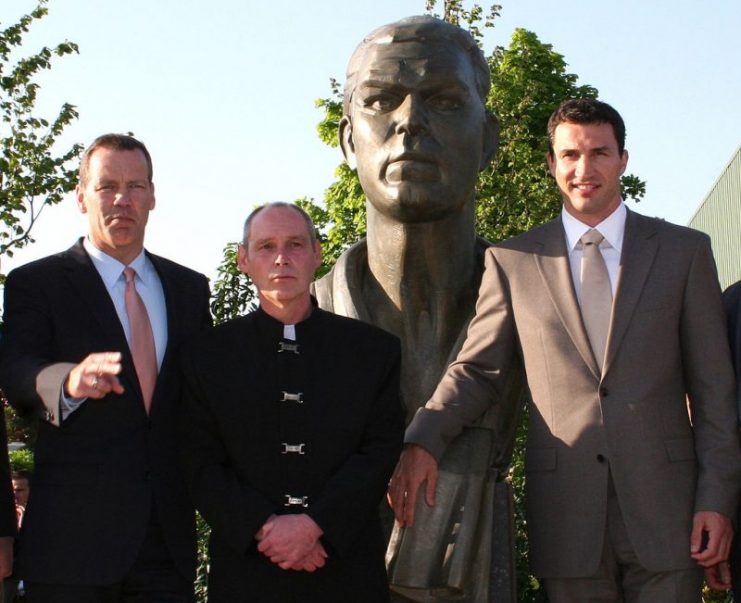
Read another story from us: Big Percy Price – The Marine That ‘Beat Up’ Muhammad Ali
Max was married for 54 years, to former European movie star Anny Ondra, and remained a boxing fan until he died. One last thing: he had become friends with Louis after their fights and again after the war.
They were never enemies, though everyone wanted them to be. Louis had money troubles throughout his life after boxing – Schmeling helped him on occasion, and even financed the champ’s funeral in 1981. Some “Nazi.”
